Practicing the CBSE Sample Papers for Class 10 Maths Standard Set 1 allows you to get rid of exam fear and be confident to appear for the exam.
CBSE Sample Papers for Class 10 Maths Standard Set 1 with Solutions
Time: 3Hr.
Max. Marks: 80
General Instructions :
- This Question Paper has 5 Sections A-E.
- Section A has 20 MCQs carrying 1 mark each.
- Section B has 5 questions carrying 02 marks each.
- Section C has 6 questions carrying 03 marks each.
- Section D has 4 questions carrying 05 marks each.
- Section E has 3 case based integrated units of assessment (04 marks each) with sub-parts of the values of 1, 1 and 2 marks each respectively.
- All Questions are compulsory. However, an internal choice in 2 Qs of 5 marks, 2 Qs of 3 marks and 2 Questions of 2 marks has been provided. An internal choice has been provided in the 2marks questions of Section E
- Draw neat figures wherever required. Take rr = 22/7 wherever required if not stated.
Section – A
Section A consists of 20 questions of 1 mark each.
Question 1.
Let a and b be two positive integers such that a = p3q4 and b = p2q3, where p and q are prime numbers. If
HCF (a, b) = pmqn and LCM (a,b) = prqs, then (m + n)(r + s) = [1]
(a) 15
(b) 30
(c) 35
(d) 72
Answer:
(c) 35
Explanation: Here, a = p3q4 and b = p2q3
HCF (a, b) = p2q3 = pmqn.
m =2,n = 3
LCM (a, b) = p3q4 = prqs
r = 3, s = 4
Then, (m + n)(r + s) = (2 + 3)(3 + 4)
= 5 × 7 = 35
Question 2.
Let p be a prime number. The quadratic equation having its roots as factors of p is [1]
(a) x2 – px + p = 0
(b) x2 – (p + 1)x + p = 0
(c) x2 + (p + 1)x + p = 0
(d) x2-px + p + 1 = 0
Answer:
(b) x2 – (p + 1)x + p = 0
Explanation: Here, in equation (b) x2 – (p + 1)x + p = 0
∴ x2 – (p + 1)x + p = 0
⇒ x(x – p) – 1 (x – p) =0
⇒ (x – p) (x – 1) =0
⇒ X = 1, p
So, the roots are the factors of p.
![]()
Question 3.
If a and β are the zeros of a polynomial f(x) = px2 – 2x + 3p and α + β = αβ, then p is [1]
(a) \(-\frac{2}{3}\)
(b) \(\frac{2}{3}\)
(c) \(\frac{1}{3}\)
(d) \(-\frac{1}{3}\)
Answer:
(b) \(\frac{2}{3}\)
Explanation: Given, f(x) = px2 – 2x + 3p
Here, α and β are the zeros of f(x).
∴ α + β = \(\alpha+\beta=-\frac{(-2)}{p}=\frac{2}{p}\)
\(\alpha \beta=\frac{3 p}{p}=3\)
According to the question, α + β = αβ
∴ \(\frac{2}{p}=3 \Rightarrow p=\frac{2}{3}\)
Question 4.
If the system of equations 3x + y = 1 and (2k – 1)x + (k – 1)y = 2k + 1 is inconsistent, then k =
(a) -1
(b) 0
(c) 1
(d) 2
Answer:
(d) 2
Explanation: Given, equations are 3x + y = 1 and (2k – 1)x + (k – 1)y = 2k + 1
on comparing it with a1, x + b1, y = c1 and
a2x + b2y = c2, we get,
a1 = 3, b1 = 1, c1 = 1, a2 = (2k – 1), b2 = (k – 1)y = 2k + 1
Condition for inconsistency \(\frac{a_1}{a_2}=\frac{b_1}{b_2} \neq \frac{c_1}{c_2}\)
\(\Rightarrow \quad \frac{3}{2 k-1}=\frac{1}{k-1} \neq \frac{1}{2 k+1}\)
\(\Rightarrow \quad 3 k-3=2 k-1\)
\(\Rightarrow \quad k=2\)
Question 5.
If the vertices of a parallelogram PQRS taken in order are P(3,4), Q(-2,3) and R(-3, -2), then the coordinates of its fourth vertex S are [1]
(a) (-2,-1)
(b) (-2,-3)
(c) (2,-1)
(d) (1,2)
Answer:
(c) (2, – 1)
Explanation: Let, the coordinates of fourth vertex be S(x, y) Since, diagonals of a parallelogram bisect each other at O
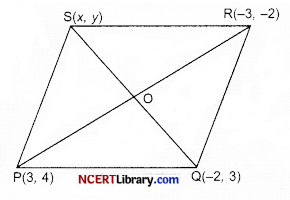
∴ Coordinates of O = \(\left(\frac{3-3}{2}, \frac{4-2}{2}\right)\) = (0,1)
O is the mid-point of QS also
∴ \(\mathrm{O}(0,1)=\left(\frac{-2+x}{2}, \frac{3+y}{2}\right)\)
∴ \(\frac{-2+x}{2}=0 \text { or } \frac{3+y}{2}=1\)
∴ \(x=2 \text { or } y=-1\)
Question 6.
△ ABC ~ △ PQR. If AM and PN are altitudes of △ ABC and △PQR respectively and AB2: PQ2 =4:9, then AM : PN = [1]
(a) 3:2
(b) 16:81
(c) 4:9
(d) 2:3
Answer:
(d) 2:3
Explanation: △ABC ~ △PQR
Ratio of corresponding sides of similar triangle and their altitude is also proportional According to the questions,
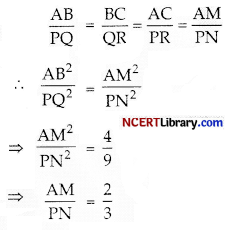
Question 7.
If x tan 60°cos 60°= sin 60°cot 60°, then x =
(a) cos 30°
(b) tan 30°
(c) sin 30°
(d) cot 30°
Answer:
(b) tan 30°
Explanation: Given: x tan 60° cos 60° = sin 60° cot 60°
\(\Rightarrow \quad x \times \sqrt{3} \times \frac{1}{2}=\frac{\sqrt{3}}{2} \times \frac{1}{\sqrt{3}}\)
\(\Rightarrow \quad x=\frac{1}{\sqrt{3}}=\tan 30^{\circ}\)
Question 8.
If sin θ + cos θ = \(\sqrt{2}\), then tan θ + cot θ =
(a) 1
(b) 2
(c) 3
(d) 4
Answer:
(b) 2
Explanation: sin θ + cos θ = \(\sqrt{2}\)
On squaring both sides (sin θ + cos θ)2 = \((\sqrt{2})^2\)
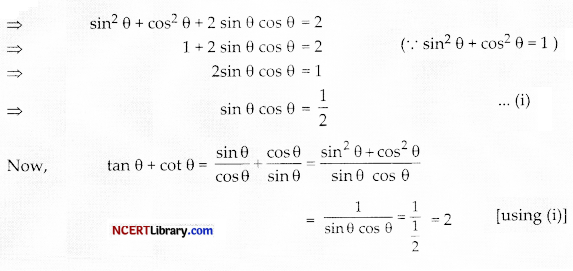
Question 9.
In the given figure, DE||BC, AE = a units, EC = b units, DE = x units and BC = y units. Which of the following is true?
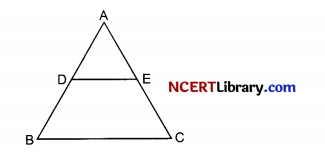
(a) \(x=\frac{a+b}{a y}\)
(b) \(y=\frac{a x}{a+b}\)
(c) \(x=\frac{a y}{a+b}\)
(d) \(\frac{x}{y}=\frac{a}{b}\)
Answer:
(c) \(x=\frac{a y}{a+b}\)
Explanation:
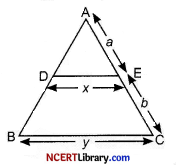
Given:
AE =a units
EC = b units
DE =x units
BC = y units
\(\frac{\mathrm{AE}}{\mathrm{AC}}=\frac{\mathrm{DE}}{\mathrm{BC}}\)
\(\Rightarrow \quad \frac{a}{a+b}=\frac{x}{y}\)
\(\Rightarrow \quad x=\frac{a y}{a+b}\)
![]()
Question 10.
ABCD is a trapezium with AD||BC and AD = 4 cm. If the diagonals AC and BD intersect each other at O such that \(\frac{\mathrm{AO}}{\mathrm{OC}}=\frac{\mathrm{DO}}{\mathrm{OB}}=\frac{1}{2}\), then BC =
(a) 6 cm
(b) 7 cm
(c) 8 cm
(d) 9 cm
Answer:
(c) 8 cm
Explanation:
Given AD||BC, AD = 4cm
\(\frac{\mathrm{AO}}{\mathrm{OC}}=\frac{\mathrm{OD}}{\mathrm{OB}}=\frac{1}{2}\)
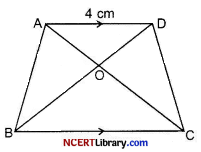
\(\angle \mathrm{OAD}=\angle \mathrm{OCB} \text { (alternate pair of angles) }\)
\(\angle \mathrm{ODA}=\angle \mathrm{OBC} \text { (alternate pair of angles) }\)
∴ \(\triangle \mathrm{AOD} \sim \Delta \mathrm{COB}\)
∴ \(\frac{\mathrm{OA}}{\mathrm{OC}}=\frac{\mathrm{OD}}{\mathrm{OB}}=\frac{\mathrm{AD}}{\mathrm{BC}}\)
\(\Rightarrow \quad \frac{1}{2}=\frac{1}{2}=\frac{4}{B C}\)
\(\Rightarrow \quad B C=8 \mathrm{~cm}\)
Question 11.
If two tangents inclined at an angle of 60° are drawn to a circle of radius 3 cm, then the length of each tangent is equal to
(a) \(\frac{3 \sqrt{3}}{2} \mathrm{~cm}\)
(b) 3 cm
(c) 6 cm
(d) \(3 \sqrt{3} \mathrm{~cm}\)
Answer:
(d) \(3 \sqrt{3} \mathrm{~cm}\)
Explanation:
In △AOB, ∠OAB = 30°, OB = 3 cm
∠OBA = 90°
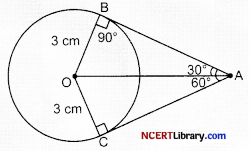
\(\text { (since, tangent } \perp^r \text { to the radius) }\)
\(\tan 30^{\circ}=\frac{\mathrm{OB}}{\mathrm{AB}}\)
\(\Rightarrow \quad \frac{1}{\sqrt{3}}=\frac{3}{\mathrm{AB}} \Rightarrow \mathrm{AB}=3 \sqrt{3} \mathrm{~cm}\)
Question 12.
The area of the circle that can be inscribed in a square of 6 cm is
(a) \(36 \pi \mathrm{cm}^2\)
(b) \(18 \pi \mathrm{cm}^2\)
(c) \(12 \pi \mathrm{cm}^2\)
(d) \(9 \pi \mathrm{cm}^2\)
Answer:
(d) \(9 \pi \mathrm{cm}^2\)
Explanation:
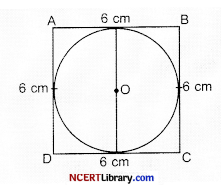
\(\text { Radius of the circle }=\frac{\mathrm{AD}}{2}\)
\(=\frac{6}{2}=3 \mathrm{~cm}\)
∴ \(\text { Area of the circle }=\pi r^2\)
\(=\pi(3)^2=9 \pi \mathrm{cm}^2\)
Question 13.
The sum of the length, breadth and height of a cuboid is \(6 \sqrt{3}\) cm and the length of its diagonal is \(2 \sqrt{3}\) cm. The total surface area of the cuboid is: [1]
(a) \(48 \mathrm{~cm}^2\)
(b) \(72 \mathrm{~cm}^2\)
(c) \(96 \mathrm{~cm}^2\)
(d) \(108 \mathrm{~cm}^2\)
Answer:
(c) \(96 \mathrm{~cm}^2\)
Explanation: Given: length (l) + breadth (b) + height (h) = \(6 \sqrt{3}\) cm
and Diagonal = \(2 \sqrt{3}\) cm
∴ \(\sqrt{l^2+b^2+h^2}=2 \sqrt{3}\)
⇒ \(l^2+b^2+h^2=12\) ….(i)
Now, \((l+b+h)^2=(6 \sqrt{3})^2\)
⇒ \(l^2+b^2+h^2+2 l b+2 b h+2 h l=108\)
⇒ \(12+2 l b+2 b h+2 h l=108\) (∵ using (i))
⇒ \(2(l b+b h+h l)=96\)
Hence, surface area of cuboid is \(96 \mathrm{~cm}^2\)
Question 14.
If the difference of Mode and Median of a data is 24, then the difference of median and mean is [1]
(a) 8
(b) 12
(c) 24
(d) 36
Answer:
(b) 12
Explanation: Given: Mode – Median = 24
By empirical formula, 3 median = mode + 2 mean
2 Median – 2 Mean = Mode – Median
⇒ 2(Median – Mean) = 24 (given)
⇒ Median – Mean = 12
Question 15.
The number of revolutions made by a circular wheel of radius 0.25m in rolling a distance of 11 km is: [1]
(a) 2800
(b) 4000
(c) 5500
(d) 7000
Answer:
(d) 7000
Explanation: Given, Radius of wheel, r = 0.25 m
Distance travelled = 11 km = 11000 m
Distance travelled in 1 revolution = \(2 \pi r=2 \times \frac{22}{7} \times 0.25\)
No. of revolution = \(\frac{11 \times 1000}{\frac{44}{7} \times 0.25}\)
\(=\frac{7}{4} \times \frac{1000}{25} \times 100\)
= 7000
Question 16.
For the following distribution,
| Class | 0 – 5 | 5 – 10 | 10 – 15 | 15 – 20 | 20 – 25 |
| Frequency | 10 | 15 | 12 | 20 | 9 |
the sum of the lower limits of the median and modal class is
(a) 15
(b) 25
(c) 30
(d) 35
Answer:
(b) 25
Explanation: Given, distribution is:
| Class | 0 – 5 | 5 – 10 | 10 – 15 | 15 – 20 | 20 – 25 |
| Frequency | 10 | 15 | 12 | 20 | 9 |
Here, modal class is 15:20 with maximum frequency 20.
| C.I | f | c.f |
| 0-5 | 10 | 10 |
| 5-10 | 15 | 25 |
| 10-15 | 12 | 37 |
| 15-20 | 20 | 57 |
| 20-25 | 9 | 66 |
| 66 |
Medium = \(\frac{N}{2}=\frac{66}{2}=33\)
∴ Median class = 10 – 15
sum of lower limits of median and modal class = 10 + 15 = 25.
![]()
Question 17.
Two dice are rolled simultaneously. what is the probability that 6 will come up atleast once?
(a) \(\frac{1}{6}\)
(b) \(\frac{7}{36}\)
(c) \(\frac{11}{36}\)
(d) \(\frac{13}{36}\)
Answer:
(c) \(\frac{11}{36}\)
Explanation: When two dice are rolled, the total outcomes are 36
Favourable cases that 6 will come up atleast once
=(1,6)(6,1)(2,6)(6,2)(3,6)(6,3)(4,6)(6,4)(5,6)(6,5)(6,6) i.e., 11
∴ P(6 will come up atleast once) = \(\frac{11}{36}\)
Question 18.
If 5 tan β = 4, then \(\frac{5 \sin \beta-2 \cos \beta}{5 \sin \beta+2 \cos \beta}\) =
(a) \(\frac{1}{3}\)
(b) \(\frac{2}{5}\)
(c) \(\frac{3}{5}\)
(d) 6
Answer:
(a) \(\frac{1}{3}\)
Explanation: 5 tan β = 4
tan β = \(\frac{4}{5}\) ….(i)
Now, \(\frac{5 \sin \beta-2 \cos \beta}{5 \sin \beta+2 \cos \beta}\)
On dividing Numerator and Denominator by cos β, we get
\(\frac{5 \tan \beta-2}{5 \tan \beta+2}=\frac{5 \times \frac{4}{5}-2}{5 \times \frac{4}{5}+2}=\frac{4-2}{4+2}=\frac{2}{6}=\frac{1}{3}\)
Question 19.
DIRECTION: In the question number 19 and 20, a statement of assertion (A) is followed by a statement of Reason (R).
Choose the correct option
(a) Both assertion (A) and reason (R) are true and reason (R) is the correct explanation of assertion (A)
(b) Both assertion (A) and reason (R) are true and reason (R) is not the correct explanation of assertion (A)
(c) Assertion (A) is true but reason (R) is false.
(d) Assertion (A) is false but reason (R) is true. [1]
Statement A (Assertion): If product of two numbers is 5780 and their HCF is 17, then their LCM is 340
Statement R (Reason): HCF is always a factor of LCM
Answer:
(b) Both assertion (A) and reason (R) are true and reason (R) is not the correct explanation of assertion (A)
Explanation: Here, product of two numbers = 5780
HCF = 17
∴ (HCF × LCM) of two number = Product of 2 numbers
17 × LCM = 5780
⇒ LCM = \(\frac{5780}{17}=340\)
Question 20.
Statement A (Assertion): If the co-ordinates of the mid-points of the sides AB and AC of △ABC are D (3,5) and E (-3,-3) respectively, then BC = 20 units
Statement R (Reason) : The line joining the mid points of two sides of a triangle is parallel to the third side and equal to half of it. [1]
Answer:
(a) Both assertion (A) and reason (R) are true and reason (R) is the correct explanation of assertion (A)
Explanation: Here, D and E are the mid-points of AB and AC
Thus, DE||BC and DE = \(\frac{1}{2} \text { BC (by B.P.T.) }\)
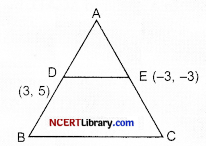
∴ By distance formula, DE = \(\sqrt{(-3-3)^2+(-3-5)^2}\)
\(=\sqrt{36+64}\)
\(=\sqrt{100}\)
= 10 units
∴ BC = 2 × DE = 2 × 10 = 20 units
Section – B
Section B consists of 5 questions of 2 marks each
Question 21.
If 49x + 51y = 499, 51x + 49y = 501, then find the value of x and y [2]
Answer:
Given, 49x + 51y = 499 ..(i)
51x + 49y = 501 ..(ii)
By adding equations (i) and (ii),
100x + 100y = 1000
⇒ x + y = 10 ……(iii)
On subtracting equations (i) from (ii), get
2x – 2y = 2
or x – y = 1
On adding equations (iii) and (iv), we get
⇒ \(x=\frac{11}{2}\)
Put this value in equation (iv), we get
y = x – 1
\(y=\frac{11}{2}-1=\frac{11-2}{2}=\frac{9}{2}\)
Question 22.
In the given figure below, \(\frac{\mathrm{AD}}{\mathrm{AE}}=\frac{\mathrm{AC}}{\mathrm{BD}}\) and ∠1 = ∠2. show that △ BAE ~ △ CAD. [2]
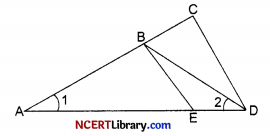
Answer:
Given: \(\frac{\mathrm{AD}}{\mathrm{AE}}=\frac{\mathrm{AC}}{\mathrm{BD}}\) and ∠1 = ∠2
To Prove: △BAE ~ △ CAD
In △ABD, ∠1 = ∠2 (given)
∴ AB = BD (opposites sides of equal angles) …(i)
Now, \(\frac{\mathrm{AD}}{\mathrm{AE}}=\frac{\mathrm{AC}}{\mathrm{BD}}\) (given)
∴ \(\frac{\mathrm{AD}}{\mathrm{AE}}=\frac{\mathrm{AC}}{\mathrm{AB}}\) (by equation (i))….(ii)
In △BAE and △CAD, by equation (ii)
\(\frac{\mathrm{AC}}{\mathrm{AB}}=\frac{\mathrm{AD}}{\mathrm{AE}}\)
and ∠A = ∠A (common)
∴ △ BAE ~ △ CAD (by SAS similarity criterion) Hence Proved
Question 23.
In the given figure, O is the centre of circle. Find ∠AQB, given that PA and PB are tangents to the circle and ∠APB = 75°

Given: PA and PB are tangents to the circle at centre O.
∠APB = 75°
Since, tangent is perpendicular to the radius at the point of contant.
∴ ∠OAP = ∠OBP = 90°
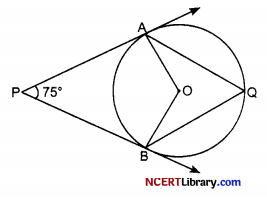
∠OAP + ∠AOB + ∠OBP = ∠APB = 360°
⇒ ∠APB = 360° – (75° + 90° + 90°)
= 360° – 255°
= 105°
Now, \(\angle \mathrm{AOB}=\frac{1}{2} \angle \mathrm{AOB}\)
(∵ angle at the remaining part of the circle is half the angle subtended by the arc at the centre)
\(=\frac{1}{2} \times 105^{\circ}=52.5^{\circ}\)
![]()
Question 24.
The length of the minute hand of a clock is 6 cm. Find the area swept by it when it moves from 7:05 p.m. to 7:40 p.m. [2]
OR
In the given figure, arcs have been drawn of radius 7 cm each with vertices A, B, C and D of quadrilateral ABCD as centres. Find the area of the shaded region.
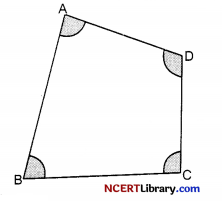
Answer:
Given: length of minute hand, r = 6 cm
Since, the tip of minute hand moves 360° in 60 min.
∴ In 1 minute, it will move = \(\frac{360^{\circ}}{60}=6^{\circ}\)
∴ From 7:05 pm to 7:40 pm i.e., 35 min., it will move through = 35 × 6° = 210°
∴ Area swept by minute hand in 35 min.
\(=\frac{\theta}{360^{\circ}} \times \pi r^2\) (Area of sector with angle 210° and radius 6 cm)
\(=\frac{210^{\circ}}{360^{\circ}} \times \frac{22}{7} \times 6 \times 6\)
\(=66 \mathrm{~cm}^2\)
OR
Radius of arcs drawn at vertices A,B,C,D of quadrilateral ABCD as centre is 7 cm.
Let the measure of ∠A, ∠B, ∠C, ∠D be Q1, Q2, Q3 and Q4 respectively
∴ Required area = (Area of sector with centre A) + (Area of sector with centre B) + (Area of sector with centre C) + (Area of sector with centre D)
\(=\frac{\theta_1}{360^{\circ}} \times \pi \times 7^2+\frac{\theta_2}{360^{\circ}} \times \pi \times 7^2+\frac{\theta_3}{360^{\circ}} \times \pi \times 7^2+\frac{\theta_4}{360^{\circ}} \times \pi \times 7^2\)
\(=\frac{\left(\theta_1+\theta_2+\theta_3+\theta_4\right)}{360^{\circ}} \times \pi(7)^2\)
\(=\frac{360^{\circ}}{360^{\circ}} \times \frac{22}{7} \times 49\) (∵ sum of four angles of quadrilateral is 360°)
\(=154 \mathrm{~cm}^2\)
Question 25.
If sin (A+B) = 1 and cos \((A-B)=\sqrt{\frac{3}{2}}, 0^{\circ}<A+B \leq 90^{\circ}\) and \(A>B\), then find the measures of angles A and B.
OR
Find an acute angle θ when \(\frac{\cos \theta-\sin \theta}{\cos \theta+\sin \theta}=\frac{1-\sqrt{3}}{1+\sqrt{3}}\)
Answer:
Given: sin (A+B) = 1
\(\cos (A-B)=\frac{\sqrt{3}}{2}\)
Then, sin (A+B) = sin 90° i.e., A + B = 90° …..(i)
cos (A-B) = sin 30° i.e., A – B = 30° …..(ii)
On solving equations (i) and (ii), we get
A = 60°
B = 30°
OR
Given \(\frac{\cos \theta-\sin \theta}{\cos \theta+\sin \theta}=\frac{1-\sqrt{3}}{1+\sqrt{3}}\)
Dividing the numerator and denominator of LHS by cos θ, we get
⇒ \(\frac{\frac{\cos \theta-\sin \theta}{\cos \theta}}{\frac{\cos \theta+\sin \theta}{\cos \theta}}=\frac{1-\sqrt{3}}{1+\sqrt{3}}\)
⇒ \(\frac{1-\tan \theta}{1+\tan \theta}=\frac{1-\sqrt{3}}{1+\sqrt{3}}\)
⇒ \((1-\tan \theta)(1+\sqrt{3})=(1-\sqrt{3})(1+\tan \theta)\)
⇒ \(1-\tan \theta+\sqrt{3}-\sqrt{3} \tan \theta=1-\sqrt{3}+\tan \theta-\sqrt{3} \tan \theta\)
⇒ \(-2 \tan \theta=-2 \sqrt{3}\)
⇒ \(\tan \theta=\sqrt{3}\)
\(\theta=60^{\circ}\)
Section – C
Section C consists of 6 questions of 3 marks each.
Question 26.
Given that \(\sqrt{3}\) is irrational, prove that \(5+2 \sqrt{3}\) is irrational.
Answer:
Let, us assume that \(5+2 \sqrt{3}\) is rational, then it can be written in the form of \(\frac{p}{q}\), where p and q are co-prime integers and q≠0.
i.e., \(5+2 \sqrt{3}=\frac{p}{q}\)
⇒ \(\sqrt{3}=\frac{p-5 q}{2 q}\) …..(i)
since, p,q, 5 and 2 are integers and q≠0, LHS of equation (i) is rational. But \(\sqrt{3}\) is irrational. This is not possible.
This contradiction arises due to the wrong assumption that \(5+2 \sqrt{3}\) is rational. Thus, \(5+2 \sqrt{3}\) is irrational.
Question 27.
If the Zeroes of the polynomial \(x^2+p x+q\) are double in value to the Zeroes of the polynomial \(2 x^2-5 x-3\), then find the values of p and q. [3]
Answer:
Given, polynomials are \(f(x)=2 x^2-5 x-3 \text { and } q(x)=x^2+p x+q\)
Let, α and β be the roots of f(x)
∴ α + β = \(\frac{5}{2}\) ..(i)
and \(\alpha \beta=\frac{-3}{2}\) …(ii)
Thus, 2α and 2β be the roots of q(x)
∴ \(2 \alpha+2 \beta=-p\)
⇒ \(2(\alpha+\beta)=-p\)
⇒ \(\frac{2 \times 5}{2}=-p\) (using (i))
⇒ \(p=-5\)
and 2α × 2β = q
So, q = 4 × αβ
\(=4 \times \frac{-3}{2}\) (using (ii))
= -6
Hence, the values of p and q are -5 and -6.
Question 28.
A train covered a certain distance at a uniform speed. If the train would have been 6 km/h faster, it would have taken 4 hours less than the scheduled time. And, if the train were slower by 6 km/hr; it would have taken 6 hours more than the scheduled time. Find the length of the journey.
OR
Anuj had some chocolates, and he divided them into two lots A and B. He sold the first lot at the rate of ₹ 2 for 3 chocolates and the second lot at the rate of ₹ 1 per chocolate, and got a total of ₹ 400. If he had sold the first lot at the rate of ₹ 1 per chocolate, and the second lot at the rate of ₹ 4 for 5 chocolates, his total collection would have been ₹ 460.
Find the total number of chocolates he had. [3]
Answer:
Let, the actual speed of the train be x km/hr and let the actual time taken be y hours.
Distance covered is xy km
If the speed is increased by 6 km/hr, then the time of journey is reduced by 4 hours i.e., when speed is (x+6) km/hr, time of journey is (y-4) hours.
∴ Distance covered = (x + 6) (y – 4)
⇒ xy = xy + 6y – 4x – 24
⇒ 4x – 6y + 24 = 0
⇒ 2x – 3y + 12 = 0 …..(i)
Similarly, xy = (x – 6) (y + 6)
⇒ xy = xy – 6y + 6x – 36
⇒ 6x – 6y – 36 = 0
⇒ x – y – 6 = 0
Multiplying equation (ii) by 3 and adding equations (i) and (ii), we get
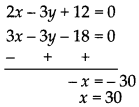
Put the value of x in equation (ii), we get
⇒ 30 – y – 6 = 0
⇒ y = 24
∴ Distance = xy = (30 × 24) = 720 km
Hence, the length of the journey is 720 km.
OR
Let, the number of chocolates in lot A be x
and Let, the number of chocolates in lot B be y.
∴ Total number of chocolates = x + y
For lot A, price of 1 chocolate = \(₹ \frac{2}{3}\)
∴ price of x chocolate = \(₹ \frac{2}{3} x\)
For lot B, price of 1 chocolate = ₹ 1
price of y chocolate = ₹ y
According to the questions, \(\frac{2}{3} x+y=400\)
or \(2 x+3 y=1200\) ……..(i)
Similarly, according to the second condition.
\(x+\frac{4}{5} y=460\)
⇒ \(5 x+4 y=2300\) ……..(ii)
On multiplying equation (i) by 5 and equation (ii) by 2, we get
5(2x + 3y = 1200)
⇒ 10x + 15y = 6000 ……(iii)
2(5x + 4y = 2300)
⇒ 10x + 8y = 4600 ……..(iv)
Now subtracting equation (iv) from equation (iii), we get
7y = 1400
⇒ y = 200
put the value of y in equation (i), we get
2x + 3 × 200 = 1200
⇒ 2x = 1200 – 600 = 600
⇒ x = 300
∴ x + y = 300 + 200
= 500
Hence, Anuj had 500 chocolates
![]()
Question 29.
Prove the following that:
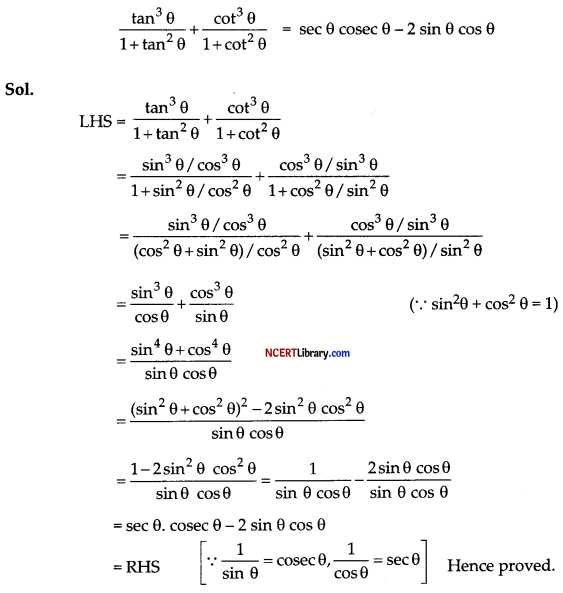
Question 30.
Prove that a parallelogram circumscribing a circle is a rhombus [3]
OR
In the figure XY and X’Y’ are two parallel tangents to a circle with centre O and another tangent AB with point of contact C interesting XY at A and X’Y’ at B, what is the measure of ∠AOB.
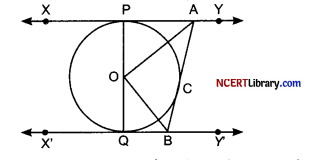
Answer:
Let ABCD be the parallelogram circumscribing the circle with centre O, such that AB, BC, CD and DA touch the circle at point P,Q R and S, respectively. We need to prove ABCD is a rhombus.
Proof: We know that tangent drawn from an external point to a circle are equal in length.
∴ AP = AS ….(i)
BP = BQ …..(ii)
CR = CQ ….(iii)
DR = DS ….(iv)
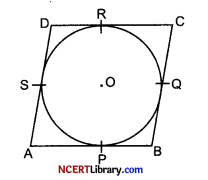
Adding equations (i), (ii), (iii) and (iv), we get
AP + BP + CR + DR = AS + BQ + CQ + DS
(AP + BP) + (CR + DR) = (AS + DS) + (BQ + CQ)
∴ AB + CD = AD + BC
Since, AB = CD and AD = BC (opposite sides of parallelogram are equal)
∴ 2AB = 2AD
or AB = AD
∴ AB = BC = CD = AD
Since, a parallelogram with equal adjacent sides is a rhombus. So ABCD is a rhombus Hence, proved.
OR
Given: XY and X’Y’ are two parallel tangents. AB is a tangent at point C.
Construction: Join OC
In △OPA and △OCA,
OP = OC (radii of same circle)
PA = AC (length of two tangents from an external point)
OA = OA (common)
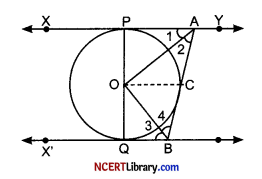
∴ \(\triangle \mathrm{OPA} \cong \triangle \mathrm{OCA}\) (by SSS congruency)
Hence, ∠1 = ∠2 (c.p.c.t)
similarly, ∠3 = ∠4
Now, ∠PAB + ∠QBA = 180° (Co – interior angles area supplementary as XY || X’Y’)
⇒ 2∠2 + 2∠4 = 180°
⇒ ∠2 + ∠4 = 90° ….(i)
In △ AOB, by angle sum property
∠2 + ∠4 + ∠AOB = 180°
⇒ 90° + ∠AOB = 180° [using (i))]
⇒ ∠AOB = 90°
Question 31.
Two coins are tossed simultaneously. What is the probability of getting
(i) At least one head?
(ii) At most one tail?
(iii) A head and a tail?
Answer:
When two coins are tossed, the total cases are HH, HT, TH, TT, i.e., 4.
(i) Favourable cases of getting atleast one head are HH, TH, HH i.e., 3.
P (atleast one head) = \(\frac{3}{4}\)
(ii) Favourable cases of getting at most one tail are HT, TH, HH, i.e., 3.
P(getting at most one tail) = \(\frac{3}{4}\)
(iii) Favourable cases of getting a head and a tail are HT, TH, i.e., 2
P(getting a head and a tail) = \(\frac{2}{4}\) = \(\frac{1}{2}\)
Section – D
Section D consists of 4 questions of 5 marks each.
Question 32.
To fill a swimming pool two pipes are used. If the pipe of larger diameter used for 4 hours and the pipe of smaller diameter for 9 hours, only half of the pool can be filled. Find how long it would take for each pipe to fill the pool separately, if the pipe of smaller diameter takes 10 hours more than the pipe of larger diameter to fill the pool? [5]
OR
In a flight of 600km, an aircraft was slowed down due to bad weather. Its average speed for the trip was reduced by 200 km/hr from its usual speed and the time of the flight increased by 30 min. Find the scheduled duration of the flight.
Answer:
Let, the time taken by larger pipe alone to fill the tank = x hours
∴ Time taken by smaller pipe = (x+10) hours
Water filled by larger pipe in 1 hour = \(\frac{1}{x}\) litre
Water filled by larger pipe in 4 hours = \(\frac{4}{x}\) litre
Water filled by smaller pipe in 1 hour = \(\frac{1}{x+10}\) litre
Water filled by smaller pipe in 9 hours = \(\frac{9}{x+10}\) litre
According to the question, \(\frac{4}{x}+\frac{9}{x+10}=\frac{1}{2}\)
⇒ \(\frac{4(x+10)+9 x}{x(x+10)}=\frac{1}{2}\)
⇒ \(\frac{13 x+40}{x^2+10 x}=\frac{1}{2}\)
⇒ x2 + 10x = 26x + 80
⇒ x2 – 16x – 80 = 0
⇒ x2 – 20x + 4x – 80 = 0
⇒ x(x – 20) + 4(x – 20) = 0
⇒ (x + 4) (x – 20) = 0
∴ x = 20 (∵ x ≠ -4, is not possible)
and x + 10 = 20 + 10 = 30
Hence, the larger pipe would alone fill the tank in 20 hours and smaller pipe would fill the tank alone in 30 hours.
OR
Let, the usual speed of the plane be x km/hr.
Then, reduced speed of the plane = (x – 200) km/hr
Given, total distance covered = 600 km
∴ Time taken with usual speed = \(\frac{600}{x} \mathrm{hr}\)
(∵ t = \(\frac { Distance }{ speed }\))
Time taken with reduced speed = \(\frac{600}{x-200} \mathrm{hr}\)
According to the question, \(\frac{600}{x-200}-\frac{600}{x}=\frac{1}{2}\)
⇒ \(\frac{600 x-600 x+120000}{x(x-200)}=\frac{1}{2}\)
⇒ x2 – 200x – 240000 = 0
⇒ x2 – 600x + 400x – 240000 = 0
⇒ x(x – 600) + 400 (x – 600) = 0
⇒ (x + 400)(x – 600) = 0
⇒ x = 600 or x= -400
But speed cannot be negative
∴ x = 600 or x = -400
But speed cannot be negative
∴ x = 600 km/hr
So, time taken for flight = \(\frac{\text { Distance covered }}{\text { Speed }}=\frac{600}{600}=1 \mathrm{hr}\)
Hence, the scheduled duration for flight is 1 hour.
![]()
Question 33.
(a) Prove that if a line is drawn parallel to one side of a triangle intersecting the other two sides in distinct points, then the other two sides are divided in the same ratio.
(b) Using the above theorem prove that a line through the point of intersection of the diagonals and parallel to the base of the trapezium divides the non-parallel sides in the same ratio. [5]
Answer:
(a) Given: A △PAR, in which MN || QR
To prove: \(\frac{\mathrm{PM}}{\mathrm{MQ}}=\frac{\mathrm{PN}}{\mathrm{NR}}\)
Construction: Join QN and MR
Proof: \(\frac{\mathrm{ar (△PNM)}}{\mathrm{ar (△QMN)}}\) = \(\frac{\mathrm{PM}}{\mathrm{MQ}}\)
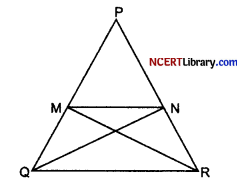
(∵ Both triangles have equal height with common vertex M)
Similarly, \(\frac { ar(△ PNM) }{ ar(△ QMN) }\) = \(\frac { PN }{ NR }\) ….(ii)
But ar(△QMN) = ar(△RNM)] ….(iii)
Because they are between same parallel lines MN and QR and on common base MN
From (i), (ii), and (iii), we get
\(\frac { ar(△PNM) }{ ar(△QMN) }\) = \(\frac { ar(△PNM) }{ ar(△RMN) }\)
⇒ \(\frac{P M}{M Q}=\frac{P N}{N R}\) Hence, proved
(b) Given: ABCD is a trapezium, in which AB || CD and EF || AB,
∴ EF || CD
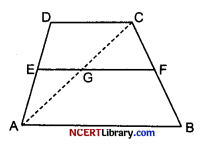
Construction: Join AC, meeting EF at G.
Proof: In △ABC, we have, GF || AB
∴ \(\frac{C G}{G A}=\frac{C F}{F B}\) (by Thales theorem) …..(i)
In △ADC, we have EG || DC
∴ \(\frac{D E}{E A}=\frac{C G}{G A}\) (by Thales theorem) …..(ii)
By (i) and (ii), we have \(\frac{\mathrm{DE}}{\mathrm{EA}}=\frac{\mathrm{CF}}{\mathrm{FB}}\) Hence, proved
Question 34.
Due to heavy floods in a state, thousands were rendered homeless. 50 schools collectively decided to provide place and the canvas for 1500 tents and share the whole expenditure equally. The lower part of each tent is cylindrical with base radius 2.8 m and height 3.5 m and the upper part is conical with the same base radius, but of height 2.1 m. If the canvas used to make the tents costs ₹ 120 per m2, find the amount shared by each school to set up the tents.
OR
There are two identical solid cubical boxes of side 7 cm. From the top face of the first cube a hemisphere of diameter equal to the side of the cube is scooped out. This hemisphere is inverted and placed on the top of the second cube’s surface to form a dome. Find
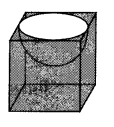
(i) the ratio of the total surface area of the two new solids formed
(ii) volume of each new solid formed. [5]
Answer:
Given, redius of the base of cylinder (r) = 2.8 m
radius of the base of cone (r) = 2.8 m
Height of the cylinder (h) = 3.5 m
Height of the cone (H) = 2.1 m
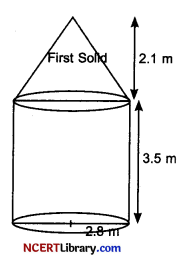
Slant height of conical part,

Area of canvas used to make tent = CSA of cylinder + CSA of cone
= \(2 \pi r h+\pi r l\)
= \(2 \times \pi \times 2.8 \times 3.5+\pi \times 2.8 \times 3.5\)
= \(\pi(19.6+9.8)\)
= \(\frac{22}{7} \times 29.4\)
= \(92.4 \mathrm{~m}^2\)
Total area of cloth required for 1500 tents = \(92.4 \times 1500 \mathrm{~m}^2\) = \(1,38,600 \mathrm{~m}^2\)
∴ Cost of 1500 tents at ₹ 120 per sq.m = 1,38,600 × 120 = 16,632,000
contribution of each school to set up tent = \(\frac{16,632,000}{50}=₹ 332,640\)
OR
Given: side of the cubical box, a = 7 cm
∴ Radius of hemisphere, \((r)=\frac{7}{2}=3.5\)
(i) SA for first solid(S1) = \(6 \times a^2+2 \pi \times r^2-\pi \times r^2\)
= \(6 \times 7 \times 7+2 \times \frac{22}{7} \times 3.5 \times 3.5-\frac{22}{7} \times 3.5 \times 3.5\)
= 294 + 77 – 38.5
= 332.5 cm2
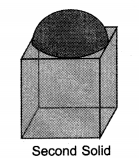
SA for second new solid (S2) = \(6 a^2+2 \pi \times 3.5^2-\pi \times 3.5^2\)
= 294 + 77 = 38.5
= 332.5 cm
∴ S1: S2 = 332.5 : 332.5
= 1:1
Hence, S1: S2 = 1:1
(ii) volume of first solid (V1) = \(a^3-\frac{2}{3} \pi \times r^3\)
= \(7 \times 7 \times 7-\frac{2}{3} \times \frac{22}{7} \times 3.5 \times 3.5 \times 3.5\)
= \(343-\frac{539}{6}\)
= \(\frac{1519}{6} \mathrm{~cm}^3\)
Volume of second new solid (V2) = \(a^3+\frac{2}{3} \pi r^3=7 \times 7 \times 7+\frac{2}{3} \pi \times(3.5)^3\)
= \(343+\frac{539}{6}=\frac{2597}{6} \mathrm{~cm}^3\)
Question 35.
The median of the following data is 525. Find the values of x and y, if the total frequency is 100.
| Class Interval | Frequency |
| 0-100 | 2 |
| 100-200 | 5 |
| 200-300 | x |
| 300-400 | 12 |
| 400-500 | 17 |
| 500-600 | 20 |
| 600-700 | y |
| 700-800 | 9 |
| 800-900 | 7 |
| 900-1000 | 4 |
Answer:
Given: Median of data = 525
| Class Interval | Frequency | Cumulative Frequency |
| 0-100 | 2 | 2 |
| 100-200 | 5 | 7 |
| 200-300 | x | x + 7 |
| 300-400 | 12 | x + 19 |
| 400-500 | 17 | x + 36 |
| 500-600 | 20 | x + 56 |
| 600-700 | y | x + y + 56 |
| 700-800 | 9 | x + y + 65 |
| 800-900 | 7 | x + y + 72 |
| 900-1000 | 4 | x + y + 76 |
| Total | 100 |
Given: 2 + 5 + x + 12 + 17 + 20 + y + 9 + 7 + 4 = 100
⇒ x + y = 100 – 76 = 24
⇒ x + y = 24
\(\text { Median, }=l+\frac{\frac{n}{2}-c f}{f} \times \mathrm{h}\)
Here, l = 500, h = 100, f = 20, cf = 36 + x and n = 100
∴ \(525=500+\frac{\frac{100}{2}-(36+x)}{20} \times 100\)
⇒ 25 (50 – 36 – x) × 5
⇒ 5 = 14 – x
⇒ x = 9
Put the value of x in equation (i), we get
y = 24 – x
= 24 – 9
= 15
Hence, the value of x = 9 and y = 15
Section – E
Case study based questions are compulsory.
Question 36.
A tiling or tessellation of a flat surface is the covering of a plane using one or more geometric shapes, called tiles, with no overlaps and no gaps. Historically, tessellations were used in ancient Rome and in Islamic art. You may find tessellation patterns on floors, walls, paintings etc. Shown below is a tiled floor in the archaeological Museum of Seville, made using squares, triangles and hexagons.
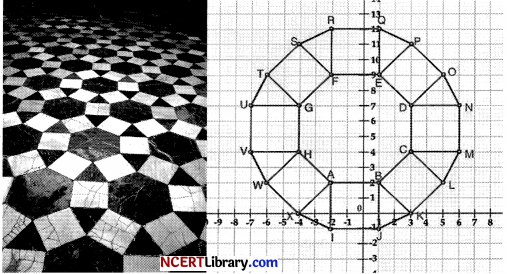
A craftsman thought of making a floor pattern after being inspired by the above design. To ensure accuracy in his work, he made the pattern on the Cartesian plane. He used regular octagons, squares and triangles for his floor tessellation pattern.
Use the above figure to answer the questions that follow:
(i) What is the length of the line segment joining points B and F? [1]
(ii) The centre ‘ Z ‘of the figure will be the point of intersection of the diagonals of quadrilateral WXOP. Then what are the coordinates of Z? [1]
(iii) What are the coordinates of the point on y axis equidistant from A and G? [2]
Answer:
(i) In the given figure, coordinates of B(1,2) and F(-2,9)
By distance formula,
BF = \(\sqrt{(-2-1)^2+(9-2)^2}\)
=\( \sqrt{(-3)^2+7^2}\)
= \(\sqrt{9+49}\)
= \(\sqrt{58} \text { units }\)
(ii) Here, coordinates of W(-6, 2), X(-4, 0), O(5,9) and P(3,11)
WXOP is a rectangle. Therefore, point of intersection of diagonals of a rectangle is the mid-point of the diagonals.
So, Mid point of WO or XP is
\(\left(\frac{-6+5}{2}, \frac{2+9}{2}\right) \text { i.e., }\left(-\frac{1}{2}, \frac{11}{2}\right)\)
(iii) In the given coordinate axes coordinates of A(-2, 2) and G(-4, 7).
Let, the point on y-axis be Z(o,y).
Since, point Z is equidistant from A and G
∴ \(\mathrm{AZ}^2=\mathrm{GZ}^2\)
⇒ (0 + 2)2 + (y + 2)2 = (0 + 4)2 + (y + 7)2
⇒ 22 + y2 + 4 – 4y = y2 + 49 – 14y
⇒ 8 – 4y = 65 – 14y
⇒ 10 y = 57
⇒ y = 5.7
Hence, the required point is (0, 5.7)
OR
What is the area of Trapezium AFGH?
Answer:
By the given figure, coordinates of A are (-2, 2)
F are (-2, 9), G are (-4, 7) and H are (-4, 4)
Here, length of GH = 7 – 4 = 3 units
length AF = 9 – 2 = 7 units
and height of trapezium AFGH = 2 units
∴ Area of AFGH = \(\frac{1}{2}\) (AF + GH) × height
= \(\frac{1}{2}\) (7 + 3) × 2
= 10 sq. units
![]()
Question 37.
The school auditorium was to be constructed to accommodate at least 1500 people.The chairs are to be placed in concentric circular arrangement in such a way that each succeeding circular row has 10 seats more than the previous one.
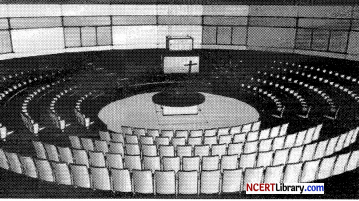
(i) If the first circular row has 30 seats, how many seats will be there in the 10th row? [1]
(ii) For 1500 seats in the auditorium, how many rows need to be there? [2]
OR
If 1500 seats are to be arranged in the auditorium, how many seats are still left to be put after 10th row?
(iii) If there were 17 rows in the auditorium, how many seats will be there in the middle row? [1]
Answer:
(i) Number of seats in first row = 30
Since, seats in each row is increasing by 10, so it forms an AP, with first row, α = 30, common difference, d = 10
Now, number of seats 10th row,
a10 = a + 9d (∵ an = a + (n – 1) d)
= 30 + 9 × 10
= 30 + 90 = 120
(ii) Since, total number of seats to be accommodate are 1500
Let, the number of row to be formed be n.
∴ \(\mathrm{S}_n=\frac{n}{2}(2 a+(n-1) d)\)
⇒ \(1500=\frac{n}{2}(2 \times 30+(n-1) \times 10)\)
⇒ 3000 = 50n + 10n2
⇒ n2 + 5n – 300 = 0
⇒ n2 + 20n – 15n – 300 = 0
⇒ n(n + 20) – 15 (n + 20) = 0
⇒ (n – 15) (n + 20) = 0
⇒ n = 15 (∵ n ≠ – 20, neglecting negative value)
Hence, number of rows are 15.
OR
Number of seats already put upto 10th row,
\(\mathrm{S}_{10}=\frac{n}{2}[2 a+(n-1) d]\)
Here, n = 10, a = 30, d = 10
\(S_{10}=\frac{10}{2}[2 \times 30+(10-1) \times 10]\)
= 5(60 + 90)
= 750
Since, total seats need to be put = 1500
S0, number of seats still required to be put are 1500 – 750 = 750
(iii) If number of rows = 17, then the middle row is the 9th row.
Then, a9 = a + 8d
= 30 + 8 × 10
= 110
Hence, number of seats in 9th row is 110.
Question 38.
We all have seen the airplanes flying in the sky but might have not thought of how they actually reach the correct destination. Air Traffic Control (ATC) is a service provided by ground-based air traffic controllers who direct aircraft on the ground and through a given section of controlled airspace, and can provide advisory services to aircraft in non-controlled airspace. Actually, all this air traffic is managed and regulated by using various concepts based on coordinate geometry and trigonometry.
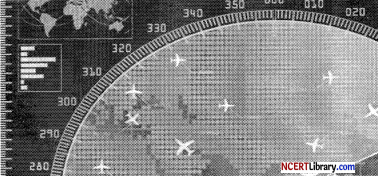
At a given instance, ATC finds that the angle of elevation of an airplane from a point on the ground is 60°. After a flight of 30 seconds, it is observed that the angle of elevation changes to 30°. The height of the plane remains constantly as \(3000 \sqrt{3}\). Use the above information to answer the questions that follow:
(i) Draw a neat labelled figure to show the above situation diagrammatically. [1]
(ii) What is the distance travelled by the plane in 30 seconds? [2]
OR
Keeping the height constant, during the above flight, it was observed that after \(15(\sqrt{3}-1)\) seconds, the angle of elevation changed to 45°. How much is the distance travelled in that duration.
(iii) What is the speed of the plane in km/hr. [1]
Answer:
(i) According to the question,
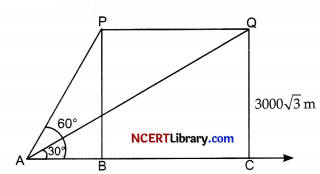
Here, P and Q are the two positions of the plane flying at a height of \(3000 \sqrt{3}\) m from the ground. Here A is the point of observation.
(ii) Considering the above figure,
In △PAB, tan \(60^{\circ}=\frac{\mathrm{PB}}{\mathrm{AB}}\)
⇒ \(\sqrt{3}=\frac{3000 \sqrt{3}}{\mathrm{AB}}\)
⇒ AB = 3000 m
In △QAC, tan 30° = \(\frac{\mathrm{QC}}{\mathrm{AC}}\)
⇒ \(\frac{1}{\sqrt{3}}=\frac{3000 \sqrt{3}}{\mathrm{AC}}\)
⇒ AC = 9000 m
∴ Distance, PQ = BC = AC – AB
= 9000 – 3000
= 6000 m
OR
According to the question, the required figure is:
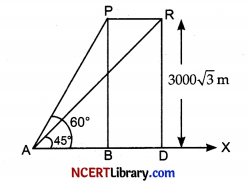
Now in △PAB, tan 60° = \(\frac{\mathrm{PB}}{\mathrm{AB}}\)
⇒ \(\sqrt{3}=\frac{3000 \sqrt{3}}{\mathrm{AB}}\)
⇒ AB = 3000 m
In △RAD, tan 45° = \(\frac{\mathrm{RD}}{\mathrm{AD}}\)
⇒ \(1=\frac{3000 \sqrt{3}}{\mathrm{AD}}\)
⇒ \(A D=3000 \sqrt{3} \mathrm{~m}\)
∴Distance travelled = PR = BD = AD – AB
= \(3000 \sqrt{3}-3000\)
= \(3000(\sqrt{3}-1) \mathrm{m}\)
(iii) Here, the distance covered by the plane is 6000 m in 30 sec.
∴ speed = \(\frac { Distance }{ time }\)
= \(\frac{6000}{30}=200 \mathrm{~m} / \mathrm{s}\)
= \(\frac{200 \times 60 \times 60}{1000} \mathrm{~km} / \mathrm{hr}\)
= 720 km/hr